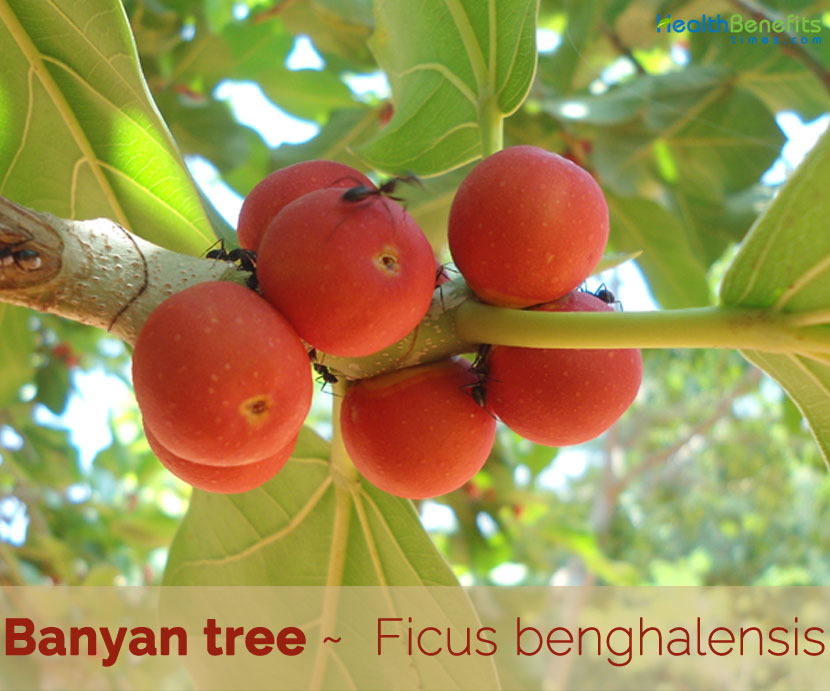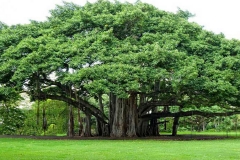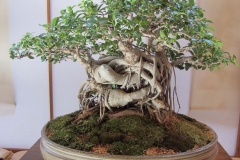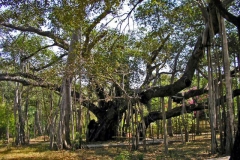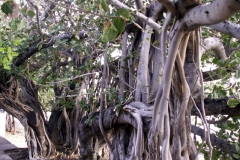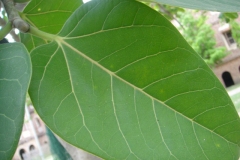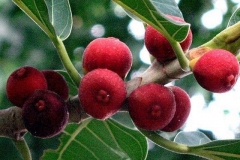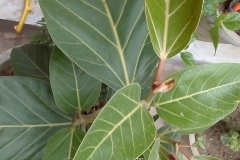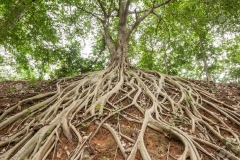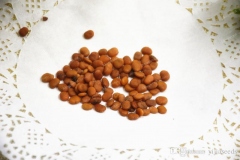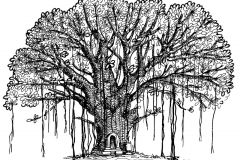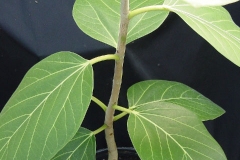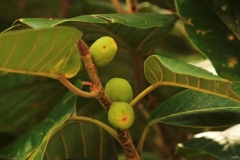Plant Description
Banyan tree is a large, evergreen to deciduous tree, up to 20-25 m tall, with wide leafy crown and branches spreading up to 100 m or more with pillar-like prop roots and accessory trunks. A single tree thus may spread over a large area and look like a small forest. This tree is considered to be sacred in some places in India. The tree is found growing in monsoon and rain forests, evergreen to deciduous lowland forest. The trunk of the tree is massive, fluted, bark is grey, smooth, young softly white puberulous. It has a main trunk 13 feet (4 m) in diameter, 230 trunks as large as oak trees, and more than 3,000 smaller ones. The largest banyan tree known is on the island of Sri Lanka. It has 350 large trunks and over 3,000 small ones. Ficus benghalensis produces propagating roots which grow downwards as aerial roots. Once these roots reach the ground, they grow into woody trunks that can become indistinguishable from the main trunk.
Leaves
Leaves are elliptic-ovate, 10-30 cm long and 7-20 cm wide, margin entire, obtuse at apex, rounded at base, coriaceous, glossy above, glabrescent of pubescent beneath, 5-7 veins, lateral veins 5-7 on either half of mid vein, looped within the margin, prominent beneath. Petiole is 2-3 cm, stipules are 1.5-2.5 cm, deltoid, acute, coriaceous.
Flower
Ficus genus is characterized by a type of involuted inflorescence called Syconium. The Syconium is a fleshy receptacle that has about 50 – 7000 florets on the inner side. The number of florets depends on the species to which the banyan tree belongs.
The Syconium seals off the florets from the outside leaving just a tiny opening at the base through which wasps can enter. The syconium can be monoecious or dioecious. The monoecious syconium has both male and female florets on the same tree. Dioecious syconium has male florets and female florets on separate trees.
Fruit
Female florets are pollinated by tiny wasps (Eupristina masoni) that enter through a small opening at the base of the fig. Once pollinated the female flowers form tiny fruits that consists of seeds. Pollination of this banyan tree is dependent solely on the wasp. If the wasp becomes extinct, the banyan tree would also become extinct. This is an example of interdependence between species to flourish.
Health benefits of Banyan Tree
Banyan tree, also known as Bargad, is intensely worshiped and honored in India. It is known for its ability to survive and grow for centuries. Besides, it holds a significant place in Hindu mythology and is supposed to fulfill wishes and other material gains, which has entitled it to be the kalpa virksha. Banyan tree not only fulfills material wishes, but also provides several health benefits. Here are some of them.
1. Prevents Tooth decay and Gum disease
Taking the aerial roots and chewing them prevents gum disease, tooth decay and bleeding gums. The aerial roots act as natural toothpaste and also help with bad breath. It also makes the teeth strong. Aerial roots have anti-bacterial and astringent properties which is effective against most oral health problems.
2. Prevents heart disease
Heart attack is the number one deathly disease in the world. Besides of the fat that clogs the artery, heart disease such as coronary heart disease might be caused by the high sodium level of human. High sodium level causes the artery narrowing and slows down the blood distribution all over the body.
Based on the research about the nutrition value of banyan tree fruit, it is found that the fruit consists of high amount of potassium which is good to lower the sodium level of the body. It also consist of natural mineral such as magnesium, phosphor, omega 3 and 6, and poliphenol which is useful to decrease the blood pressure and prevents coronary heart disease. Experts state that consuming banyan tree fruit at least once a day will reduce the risk of sudden heart attack.
3. Prevents cancer
Besides preventing heart attack, another health benefit of banyan tree fruit is preventing the second deathly disease in the world, which is cancer. There are some factors of cancer. One of them is the amount of free radical. Free radical will damage the skin cell and activate the up normal cell growth which is known as cancer cell. Banyan tree fruit consumption enables to provide the need of polyphenol which performs as antioxidant to fight the free radicals.
There are some kinds of cancers which is able to be prevented using banyan tree fruit, such as cervical cancer, prostate cancer, breast cancer, brain cancer, and colon cancer.
4. Boost Immunity
Strong immunity is quint essential to having a healthy life. Immunity helps you fight against diseases and protect you from them. Bark of the banyan tree is a good immune boosting agent.
5. Diarrhea and Dysentery
Leaf buds of the banyan tree are beneficial in the treatment of chronic diarrhea and dysentery. Buds should be soaked in water’ overnight and taken as infusion in the treatment of these diseases. Latex is also useful in the treatment of diarrhea and dysentery.
6. Help to control weight
Banyan tree fruit is magically able to both increase and reduce weight. To increase weight, we can regularly consume the banyan tree fruit juice with milk right before going to bed. Dietary fiber contained in the banyan tree fruit able to increase weight and build a tight body posture without adding the amount of fat in our body. On the other hand, to reduce weight, we can drink banyan tree fruit juice without milk and sugar. The treatment will be effective along with the regular exercise.
7. Maintains good vision
Consuming three or more banyan tree fruit daily is supposed to reduce the risk of age related macular degeneration. Banyan tree fruit consists of high level of vitamin A, C, and E that maintain the good vision.
8. Piles
Few drops of the latex of the banyan tree mixed in milk and taken daily help to cure bleeding piles. With this treatment, the diet of the patient should contain liberal quantities of green vegetables particularly fenugreek and manattakkali or black nightshade leaves.
9. Female Sterility
Tender roots of the banyan tree are considered beneficial in the treatment of female sterility. These roots should be dried in the shade and finely powdered. This powder should be mixed 5 times its weight, with milk, and taken at night for 3 successive nights after menstruation cycle every month till the conception takes place. No other food should be taken with this.
10. Leucorrhoea
Regular douching of the genital tract with a decoction of the bark of the banyan tree and the fig tree is helpful in leucorrhoea. Tablespoon each of the powders of the bark of the two trees should be boiled in a lt. of water till it is reduced to about half. Douching with the lukewarm decoction will keep the tissues of vaginal tract healthy.
11. Skin Disorder
Hot poultice of the leaves can be applied with beneficial results to abscesses to promote suppuration and to hasten their breaking. The milky juice from the fresh green leaves is beneficial in destroying warts. The latex is commonly used locally for sores, ulcers and bruises.
12. Treats Vaginal Infections
Vaginal infections can happen due to lack of hygiene and because the vagina remains moist. Banyan tree bark as well leaves can treat vaginal infections. Crush a handful of dried banyan leaves to make a tablespoon of powder. Boil this powder in a liter of water until the water reduces to half a liter. Let the infusion cool and then apply on the affected area.
13. Enhances immune system
One of the health benefits of banyan tree fruit is enhancing immune system. Flavonoid, polyphenol, and vitamin C which are the antioxidant of banyan tree fruit able to enhance your immunity. It is beneficial to avoid both mild and severe disease.
14. Regulates the blood sugar
Banyan tree fruits known for its sweetness and doctors may not recommend something sweet for diabetics. However, although banyan tree fruit is sweet, the fructose and glucose in it will not raise your blood sugar. Besides fructose and glucose, the banyan tree fruit also consist of unsaturated fiber and carbohydrate which will slow down the process of excess sugar absorption on your digestive system.
Additionally, the potassium will help regulate the amount of sugar absorbed after we had a meal. So, we all now know the health benefits of banyan tree fruit.
15. Maintains body fitness
Banyan tree fruit water is also able to maintain body fitness if it is drunk once a day. You can either boil the fruit in the water and drink the water or make infused water using the banyan tree fruit pulps combined with your favorite fruits.
16. Reduces respiratory problems
One of the respiratory syndromes which are commonly experienced is asthma. Asthma is usually caused by infection on human respiratory system, especially on the alveolus. Regular banyan tree fruit consumption will help reduce the problems, since it consists of antibacterial and antiseptic that will effectively reduce the infection.
Besides, banyan tree fruit contains high amount of natural fluids which help decrease the pain because of the sore throat. Consuming banyan tree fruit juice without will humidify the dry and inflamed throat.
17. Prevents anemia
Banyan tree fruit benefit for anemia is incredible. It is able to enhance the hemoglobin formation in the blood. It is possible since the banyan tree fruit consist of high level of iron. We know that iron is the main component in hemoglobin formation.
18. Helps fight hemorrhoid
Some research states that banyan tree fruit is able to cure hemorrhoid. It is also supported by a comprehensive research on banyan tree fruit, and certainly, the banyan tree fruit has high flavonoid level which is able to prevent inflammation because of the hemorrhoid.
19. Cures kidney stones
Banyan tree fruit consists of diuretic element which is able to shed residue and stone in the kidney. Thus, it is suggested for the kidney stones sufferer to frequently drink banyan tree fruit water once a day.
20. Strengthen bones
Osteoporosis is one of the diseases that can be prevented by regularly consuming banyan tree fruit. Banyan tree fruit consists of high level of calcium. According to nutritionist, calcium and phosphor level contained in banyan tree fruit is higher than the calcium and phosphor in milk.
Thus, it is good for you to consume the fruit since it is able to fulfill the need of calcium. Particularly for those above 30, the calcium will help you prevents osteoporosis. And for children, it will help to strengthen teeth, bones and naturally increase height.
21. Helps insomnia problems
Insomnia problems may appear because of some factors such as excessive caffeine consumption and stress. Thus, to solve the problems, the sufferer should reduce the caffeine consumption and relieve stress.
22. Prevents Alzheimer
Banyan tree fruit consists of vitamin B6 that helps to improve concentration. Regular consumption of it performs the health benefit of banyan tree fruit which is able to prevent the degenerative brain disease such as Alzheimer.
23. Lowers cholesterol
Unsaturated fat in banyan tree fruit is good to lower the cholesterol. It is able to perform it benefits because of the pectin of the unsaturated fat will get rid the cholesterol through human’s excretion system such as feces, urine, and sweat.
24. Anti-aging
Aging is the normal process for everybody. However the anti-oxidant contained in the banyan tree fruit is supposed to be able to slow down the aging process, for those who regularly consume banyan tree fruit. Thus, it is highly recommended for women particularly in their menopause period to regularly consume banyan tree fruit.
25. Moisturizes skin
High water level in banyan tree fruit helps to reduce toxic and water from the body, so that it is able to give you a moist and glowing skin. You can make banyan tree fruit into paste and use it as face pack. Apply it on your face and let it dry for about 15 minutes to allow the paste transport nutrients into the dermal layer. After that, wash it with lukewarm water.
26. Cures injuries and abscess
Both of injuries and abscess can be cured by banyan tree fruit because it consists of antiseptic which is good to fight bacteria. Antiseptic on banyan tree fruit is able to prevent the inflammation and infection on the skin. In order to do so, we can simply smash the pulps and apply it on the injured skin until it dried, and then wash with cool water.
27. Maintains healthy hair
We can maintain our healthy hair by using the banyan tree fruit, since it is able to be used as natural conditioner. This is why we can find shampoo with banyan tree fruit extract on it. Ancient people had used banyan tree fruit as their essential hair treatment in the past. Magnesium, vitamin A, C, E, in banyan tree fruit encourages blood circulation in the scalp and accelerates hair growth.
28. Good for pregnancy
As we know, banyan tree fruit contains valuable nutrition. Some of them such as folate, protein, dietary fiber, calcium, and the other natural mineral make this fruit very good for the pregnant mom and its fetus. Additionally, the zinc contained in the banyan tree fruit is also beneficial for the mother who has just given birth.
29. Improves men’s vitality
Men’s vitality is one of the significant factors to maintain good married relationship. From long ago, Banyan tree fruit is supposed to be able to enhance men’s vitality. We can just take out the fresh pulps of banyan tree fruit and pour it into a glass of milk. Soak it for a night long and drink it in the morning regularly.
Traditional uses and benefits of Banyan Tree
- Bark, leaves, root-fibers, and milky juice (latex) are used in the preparation of traditional medicines.
- Milky latex is applied directly over the wound and swelling for quick relief.
- Decoction of the bark is given in a dose of 50-70 ml to treat vaginal diseases.
- Decoction of the bark or the fruit is given to control diabetes.
- Tender leaves are given in the form of decoction to strengthen the uterine muscles during pregnancy.
- Latex of the tree is used to treat cases of premature ejaculation.
- Latex is applied locally in dental caries, conjunctivitis and skin diseases as part of treatment.
- For the firmness of the breast in females, the paste of the aerial roots is applied locally.
- Buds is added with peepal and ficus glomerata and processed with ghee and mixed with honey and sugar for consumption to treat diarrhea.
- Decoction prepared from leaf bud of vata, jambu and ushira is taken with honey in a dose of 40-50 ml to treat Nausea and vomiting.
- To cure snake poisoning paste of root of banyan tree is mixed with juice of Durva, Manjishta, jivaka and Kashmarya and is consumed.
- Cold infusion from the tender buds is given in a dose of 40-50 ml to treat excessive sweating.
- Its leaf, bark, seeds and fig are used for the variety of disorders like diarrhea, polyuria, dental, diabetes and urine disorders.
- Leaves are used to remedy dysentery and diarrhea.
- They are used in a decoction with toasted rice as a diaphoretic.
- Young leaves are heated and used as a poultice.
- They are applied to abscesses as a poultice to promote suppurations and discharge of pus.
- Concentrated latex, combined with the fruit, is aphrodisiac and is used to treat spermatorrhoea and gonorrhea.
- Mixed with sugar, it is used as a treatment for dysentery in children.
- Milky latex in the plant is applied topically to treat toothache, bruises, painful areas, rheumatic joints and lumbago.
- It is dripped into wounds in order to kill or expel germs, and is applied to treat bleeding and swelling of the gums.
- An infusion is anti-diabetic and a decoction is used as an astringent in the treatment of leucorrhoea.
- Decoction of the root fibers is useful as a treatment against gonorrhea, whereas the tender ends of the aerial roots are used for obstinate vomiting.
- An infusion of the twigs is a useful remedy for hemoptysis.
- Milky latex is used against fever and applied to cracked and inflamed soles.
- Paste made from its prop roots is applied on the hair, to keep them healthy and lustrous.
- Mixture prepared from its leaves is a good herbal remedy for treating Eczema.
- Its sap is best in combating skin bruises and inflammation.
- Fresh and warm Banyan leaves are used for Boils.
- Paste prepared from its leaves is applied on pimples, acne and rashes to treat them.
- Latex of the tree mixed with milk is suitable for chapped heels.
- Decoction prepared from its bark is used to get rid of bad breath and oral ulcers.
- Root is used to strengthen teeth and gums and keeps away the chance of encountering Pyorrhea.
- Its bark and seeds are used to control body temperature.
- Paste made from its latex is effective for rheumatism and lumbago.
- It is a best herbal cure for Vomiting. Its latex and leaf buds are beneficial for treating chronic diarrhea and chronic dysentery.
- Decoction of its latex taken with milk is used to treat bleeding piles. It helps in counteracting leucorrhoea.
- It is a good herbal medicine for diabetes. Its bark needs to be soaked overnight and the infusion should be taken the next day.
- Syrup made from its bark when taken with honey and water is a good herbal remedy to treat venereal diseases.
- Root powder mixed with milk is beneficial in treating and maintaining female fertility.
- Milk juice obtained from tree bark is also used as a natural remedy to get rid of skin moles.
Ayurvedic Health benefits of Banyan Tree
- Backache: Take out the milk of banyan tree. Apply it over the back twice a day.
- Impotence: Take some ripe fruits of Banyan. Dry them in shadow and grind coarsely. Add powdered Sugar Candy. Take one teaspoon twice a day. One in early morning and other one at bed time for one month.
- Leucorrhoea: Take 5 drops of Banyan milk thrice a day. OR: Take dried Banyan bark. Grind. Have one teaspoon with lukewarm milk twice a day.
- Infertility: Dry some Banyan roots under sun for few days. Grind to make a fine powder. Take 1 teaspoon every day with warm milk. Take the remedy for 1 week only. Make sure you take the remedy 1 week after your menses. It is recommended for both male and female infertility.
- Warts: Apply the juice of the trunk of Banyan tree to the affected area twice a day.
- Gingivitis: Boil bark of Banyan tree in a cup of water. Strain and use the liquid for gargling.
- Piles: Add 2 ml Latex of Banyan Tree in a glass of Milk. Drink once a day.
- Libido loss Female: Crush dried roots of Banyan tree to make powder. Take half tsp. of it with warm milk once a day.
- Ruptured skin: Crush the fruit of Banyan Tree to make paste. Apply it over damaged Skin
- High Cholesterol: Take 4 g bark powder of Banyan Tree with lukewarm water once a day.
- Cuts: Crush the fruit of Banyan Tree. Apply it over ruptured Skin.
- Ulcers: Apply the fruit paste of Banyan Tree over infected Skin.
- Diarrhea: Consume a fruit of Banyan Tree in a day.
- Antibacterial: Sprinkle barks powder of Banyan over damaged Skin.
- Premature Ejaculation: Powder the dried fruits of Banyan. Take 10 g of it. Add same quantity Sugar and 5 g of Cumin seed powder. Take 1 tsp. with a glass of warm Milk. Have it once a day. (For Physical weakness associated with premature ejaculation or night emission, consume 2 teaspoons of Peepal leaf powder every day.)
- Female Disease: Take Banyan fruit powder, Sugar and Cumin powder in 2:2:1 ratio. Take half tsp. of it twice a day with Milk.
- Cracked Heels: Apply latex of Banyan tree over Cracked Heels.
- Abscess: Heat few leaves of Banyan tree. Coat it with Sesame oil. Tie it over Boils. It helps in forming pus in them.
- Diabetes: Make an infusion using bark of Banyan. Consume 15 ml twice a day.
- Bad breathe: Make a bark decoction Banyan tree. Swish using it.
- Sexually Transmitted diseases: Add 1 tsp. bark powder of Banyan tree in 2 cups of water. Boil until it gets half. Add Honey in it. Drink 25 ml twice a day.
- Eczema: Take few leaves of Banyan tree. Crush them to make a paste. Apply over damaged Skin.
- Yellow Teeth: Take a washed root of Banyan tree. Rub this root against your teeth and chew it as well. Then wash off your mouth after 5 minutes of brushing. Keep doing it daily.
- Oligospermia: Take few dried Banyan fruit. Make a powder and have 1 tablespoon daily with warm water. It enhances the production of Sperms.
- Nose bleeds: Take Leaves extract and put 3 to 4 drops in each Nostril.
- Stomach Problems: Prepare a tea from Banyan Leaves and drink it 2 times in a day.
- Wrinkles: Banyan has anti-aging properties. Make a paste of Banyan leaves and mix it with Honey. Apply this paste on the affected areas. Leave it for 10 to 15 min. Rinse with cold water.
- Urticaria: Take 1 tablespoon of clarified butter; add a pinch of black pepper to it. Heat it on low flame for 2 to 3 min. Now add 1 tablespoon of Banyan leaf paste and consume it with warm water.
- Epilepsy: Consume 10 drops of Banyan leaf extract 3 times in a day.
- Whooping Cough: Take 1 tablespoon dried fruit powder every day.
- Watery Semen: Take 1 teaspoon of fresh Banyan milk with a glass of water on empty stomach. Take it for 1 week. It is beneficial in treating thin semen.
- Bad breathe: Take half cup of Azadirachta Indica bark, Chebulic Myrobalan, One cup of aerial roots of Banyan, One tablespoon Cloves and One tablespoon Camphor. Use this mixture as a tooth powder thrice a day after meals.
- Lower back pain: Take Banyan milk and Flax seed oil in equal quantity. Apply it on back once a day.
- Burns: Take Banyan leaves. Grind them with equal quantity of Yogurt (Curd). Apply the mixture on the affected part.
- Toothache: Take 5 tablespoons Powdered Banyan Bark, 1/4 teaspoon Powdered Catechu and 1/4 teaspoon Powdered Black Pepper. Mix all the above herbs. Use it as tooth powder twice a day.
Daily Recommendation Intake
Despite the health benefits of banyan tree fruit, it is strongly recommended to pay attention of the consumption intake. Therefore, it is better to consume no more than 40 grams of banyan tree fruit in a day. The 40 grams equivalents with 4 – 5 fresh banyan tree fruits. By consuming the right portion, we will able to take the benefits of banyan tree fruit and avoid the side effect.
Other facts
- Ficus benghalensis is often planted as an ornamental.
- Tree is also planted for soil conservation, timber and pulp paper.
- Leaf is used in the preparation of fodder.
- It is also cultivated as a shade tree along streets, in parks and gardens, and grown as a host plant for lac insects.
- Fruit is edible, but is eaten only in famine times.
- Wood of the Banyan tree is used in making door panels, boxes and the other items.
- In India its edible leaves are used as the plates.
- Wood is used for well curbs, door panels, boxes, furniture etc.
- It is suitable for paper pulp.
- Wood of the aerial roots is stronger and is used for the tent poles and cart yokes.
- Banyan tree is respected and is considered as sacred by the people in India.
- Banyan tree is considered as the male plant closely related to the Peepal tree.
- It is probably the biggest and friendliest of all trees.
- Banyan tree is the tree of knowledge and tree of life.
- Aerial roots are used for temporary binding materials.
- Latex obtained from all parts of the plant can be used to produce an inferior quality rubber.
- It is used locally for poles, cart yokes, furniture and to line wells.
- Low-quality wood, it is not suitable for general use, but it might be used for secondary cabinet work, such as the linings of drawers and cabinets.
- Fiber from the bark is used for making paper and ropes.
- The largest banyan tree known is on the island of Sri Lanka. It has 350 large trunks and over 3,000 small ones.
- It is the national tree of India.
- Milky sap from the tree is used for polishing metal wares.
Control Methods
Physical control
It is uncertain if small seedlings on the ground or as epiphytes can be pulled. Control of Ficus species seems daunting. Often, trees will germinate on and grow as epiphytes on other desirable trees, concrete structures, and fence posts. These are sometimes out of reach or on steep dangerous terrain. Care will need to be taken in order to successfully kill the unwanted Ficus while preserving the host. Without control, the host tree or structure is in danger of destruction through strangulation. Control of spreading Ficus trees in Hawai’i is just beginning to be explored. In Florida, Nadel et al. report that trials made in Bermuda of pruning large trees (about 30) during the off season to create a gap in syconial availability were not successful.
Chemical control
Fig trees are particularly sensitive to triclopyr herbicides as a basal or cut-stump treatment. Trees found growing on concrete or rock structures should be treated with herbicide while young to avoid costly structural damage. Use extreme caution when applying herbicide to figs growing as epiphytes to ensure that the poison does not contact the host tree. When exotic figs germinate high in the branches of large trees in natural forest communities, it may be extraordinarily difficult to get close enough to the fig to treat it.
Biological control
Nadel et al. report several pests that could be looked at for biological control potential including various ants which were seen carrying off pollinator wasps from Ficus fruits, Hymenoptera and mites that may be parasites of the pollinator wasps, and staphylinids which were seen entering Ficus fruits and eating the pollinator wasps.
Cultural control
The pollinator wasps should be prevented from entering Hawaii in order to prevent spread of F. benghalensis.
References:
https://www.itis.gov/servlet/SingleRpt/SingleRpt?search_topic=TSN&search_value=506543#null
https://davesgarden.com/guides/pf/go/54562/
http://www.hear.org/pier/species/ficus_benghalensis.htm
https://www.cabi.org/isc/datasheet/24066
https://plants.usda.gov/core/profile?symbol=FIBE2
http://www.theplantlist.org/tpl/record/kew-2809652
https://en.wikipedia.org/wiki/Ficus_benghalensis
https://indiabiodiversity.org/species/show/31316
https://hort.purdue.edu/newcrop/CropFactSheets/ficus.html
https://gd.eppo.int/taxon/FIUBG
http://tropical.theferns.info/viewtropical.php?id=Ficus+benghalensis
http://powo.science.kew.org/taxon/urn:lsid:ipni.org:names:852482-1
http://www.hear.org/Pier/pdf/pohreports/ficus_benghalensis.pdf
http://www.flowersofindia.net/catalog/slides/Banyan%20Tree.html
https://npgsweb.ars-grin.gov/gringlobal/taxonomydetail.aspx?id=16783
https://en.wikipedia.org/wiki/Banyan
Comments
| Banyan tree Quick Facts | |
|---|---|
| Name: | Banyan tree |
| Scientific Name: | Ficus benghalensis |
| Origin | Tropical Asia, from India through Myanmar, Thailand, southern China, and Malaysia |
| Colors | Initially green ripening to purple or reddish brown |
| Shapes | Globose to depressed-globose, 15-2.5 cm in diameter, hairy |
| Taste | Bitter, pungent, astringent |
| Health benefits | Prevents Tooth decay and Gum disease, Prevents heart disease, Prevents cancer, Boost Immunity, Diarrhea and Dysentery, Help to control weight, Maintains good vision, Piles, Female Sterility, Leucorrhoea, Skin Disorder, Treats Vaginal Infections, Enhances immune system, Regulates the blood sugar, Maintains body fitness, Reduces respiratory problems, Prevents anemia, Helps fight hemorrhoid, Cures kidney stones, Strengthen bones, Helps insomnia problems, Prevents Alzheimer, Lowers cholesterol, Anti-aging, Moisturizes skin, Cures injuries and abscess, Maintains healthy hair, Good for pregnancy, Improves men’s vitality |
| Name | Banyan tree |
|---|---|
| Scientific Name | Ficus benghalensis |
| Native | Tropical Asia, from India through Myanmar, Thailand, southern China, and Malaysia. It is also cultivated and naturalized in many tropical regions of the world including western Africa, North America, the West Indies, Australia, the Middle East, and many islands in the Pacific ocean |
| Common Names | Banyan fig, Banyan tree, East Indian fig tree, Indian banyan, Weeping Chinese banyan, Bengal banyan, Bengal fig, Horn fig, banyan, vada tree |
| Name in Other Languages | Afrikaans: Banyan Albanian: Banyan Arabic: Fyks binifali (فيكس بنفالي), tyn bnghaly (تين بنغالي), banyan (بانيان) Armenian: Banyan Assamese: Bot, Bor-goch Azerbaijani: Banyan Bahamas: Banyan tree Basque: Banyan Belarusian: маклер Bengali: Aśbat’tha gācha (অশ্বত্থ গাছ) Bar, Bat, Bath, Bot, bata (বট) Bosnian: Banyan Bulgarian: Posrednik (посредник) Burmese: Pyi nyaung, Pyin vaung Catalan: Banyan Cebuano: Banyan Chichewa: Banyan Chinese: Meng jia la rong (孟加拉榕), Róngshù (榕树) Croatian: Banyan Czech: Banyán Danish: Indisk figen, Banyan Dutch: Waringin English: Banyan fig, Banyan tree, East Indian fig tree, Indian banyan, Weeping Chinese banyan, Bengal banyan, Bengal fig, Horn fig, banyan, vada tree Esperanto: Banyan Estonian: Bengali viigipuu Filipino: Banyan Finnish: Banyan French: Banian, Figuier d’Inde, Figuier des pagodes, Arbre banian, banyan du Bengale, figuier banyan Galician: Banyan Georgian: Banyan German: Banyanbaum, Bengalischer Feigenbaum, Banyan-Feige, Indischer; Feigenbaum, Würg, indischer Banyanbaum, Würgfeigenbaum Greek: Indosýki (ινδοσύκη) Gujarati: Vad, Vadlo, વડ vad, bayana (બયાન) Haitian Creole: Banyan Hausa: Banyan Hebrew: פיקוס בנגלי , בניאן Hindi: Bad (बड़), Bargad, Bargat (बरगद), Barh (बर) Bar, Bat (बट) Bata, Bhaandiir (भाण्डीर), Vata (वट ), barh (बढ़), nyagarodh (न्यगरोध) Hmong: Banyan Hungarian: Indiai fügefa Icelandic: Banyan Igbo: Banyan Indonesia: Beringin Irish: Banyan Irula: Aalamaram Italian: Banyan Japanese: Bengaru bodaiju (ベンガルボダイジュ), Baniyan (バニヤン) Javanese: Waringin Kannada: Ala, Alada, Alada mara, Aalada mara, Goli, Nyagrodha, Vata, aaladamara (ಆಲದಮರ), basarimara (ಬಸರಿಮರ), golimara (ಗೋಳಿಮರ), Gōṇimara (ಗೋಣಿಮರ) gonimara, vatavruksha (ವಟವ್ಱುಕ್ಷ), alada (ಆಲದ) Kanarese: Ala Kashmiri: Bad Kazakh: Banyan (Баньян) Khmer: Pothi (ពោធិ) Konkani: Goli rooku (गोळी रूकु), vada rooku (वडा रूकु) Korean: Ban-yan namu (반얀 나무) Lao: Banyan Latin: Banyan Latvian: Banjans Lithuanian: Banyan Macedonian: Banyan Malagasy: Banyan Malay: Ara, Pokok ara, beringin Malayalam: Ala, Peraal, Peral, Vatam, Vatavarksam, pērāt (പേരാത്) peeraath, peraal (പേരാല്), ālmaraṅṅaḷ (ആൽമരങ്ങൾ) Malaysia: Ara tandok, bohdi Maltese: Banyan Manipuri: Khongnang taru Maori: Banyan Marathi: Marri, Peddamarri, Vad (Vadd, Vada), Wad, hajaripaan (हजारीपान), nyagrodh (न्यग्रोध), vad (वड), vadangale (वडांगळें), vat vruksh (वट वृक्ष), Vaḍācē jhāḍa (वडाचे झाड) Mongolian: Banyan (баньян) Myanmar: Pyi-nyaung, nyaung motesate (ညောင်မုတ်ဆိတ်) Nepali: Bar, banyan Norwegian: Banyan Oriya: Baragachha, bata, bara Pakistan: Bar, barged, barh, peepal Persian: انجیر هندی Polish: Banyan Portuguese: Figueira-banyan, figueira-bargá, barga, banyan Punjabi: Bar, bhod, bhaur Romanian: Banyan Rotuman: Paka Russian: Makler (маклер) Samoan: Pulu Sanskrit: Akshaya vruksham, Avaroha, Bahupada, Bat, Bhringi, Jatalo, Nyagrodha, Vat, Vata, Vatah, nyagrodh (न्यग्रोध), vata (वट) Serbian: Indijska smokva, Баниан Sesotho: Banyan Sinhalese: Maha nuga,nuga (නුග) Slovak: Banyan Slovenian: Banyan Somali: Banyan Spanish: Baniano, Higuera de Bengala, secretario Swahili: Banyan Swedish: Banianträd, banyan Tajik: Banyan Tamil: Aal, Al (ஆல்), Alam (ஆலம்), Aalam vizhudhu, Alamaram (ஆலமரம்), Peral, alai (ஆலை) Telegu: Mari peddamari, Marri, Peddamarri, Vata vrikshamu, marri chettu (మర్రి చెట్టు) Thai: Krang (กร่าง), Ni khrot (นิโครธ), T̂nthịr (ต้นไทร) Turkish: Hint inciri Ukrainian: Makler (маклер) Urdu: bar (بر), bat, bargad, برگد Uzbek: Banyan Vietnamese: Cây đa, Cây sanh, Cây dong, Ða lá tròn, banyan Welsh: Banyan Yiddish: Banyan Yoruba: Banyan Zulu: Banyan |
| Plant Growth Habit | Large, fast growing, evergreen tree |
| Growing Climates | Monsoon and rain forests, Evergreen to deciduous lowland forest |
| Plant Size | Up to 20-25 m tall |
| Trunk | massive, fluted, bark grey, smooth, young softly white puberulous |
| Leaf Fall | March–April |
| Leaf | Elliptic-ovate, 10-30 cm long, 7-20 cm wide, margin entire, obtuse at apex, rounded at base, coriaceous, glossy above, glabrescent of pubescent beneath, 5-7 veins, lateral veins 5-7 on either half of midvein, looped within the margin, prominent beneath. Petiole 2-3 cm, stipules 1.5-2.5 cm, deltoid, acute, coriaceous |
| Flowering season | March–April |
| Flower | Ficus genus is characterized by a type of involuted inflorescence called Syconium. The Syconium is a fleshy receptacle that has about 50 – 7000 florets on the inner side. The number of florets depends on the species to which the banyan tree belongs |
| Fruit Shape & Size | Globose to depressed-globose, 15-2.5 cm in diameter, hairy |
| Fruit Color | Initially green ripening to purple or reddish brown |
| Propagation | Through seed, transplanting and stem-cutting |
| Taste | Bitter, pungent, astringent |
| Plant Parts Used | Aerial root, Bark, root-fibers, leaves, seeds, milky juice, buds, fruit, latex |
| Season | March–May |
| Health Benefits |
|
| Precautions |
|
| How to Eat |
|


